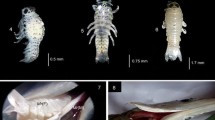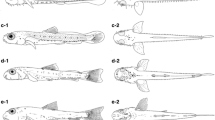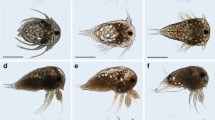Abstract
This paper reports the occurrence of life cycle dependent monophasic and biphasic molting in Mothocya renardi (Bleeker, 1857), a protandrous hermaphroditic cymothoid parasitizing the banded needle fish, Strongylura leiura. Although the molting in manca I is monophasic, the infective manca II, juvenile and adult stages including male, transitional, and female opt biphasic molting in which the posterior half of the body molts first, followed by the anterior half. The molt cycle (monophasic and biphasic) in M. renardi is broadly divided in to four sequential stages, premolt, molt, postmolt and intermolt. Five distinct premolt stages (D0-D4) were also identified through the microscopic observation of characteristic changes reflected in different appendages of manca stages and adult infective stages. Pleotelson, uropod rami and dactylus of the first pereopod and antennae were used for the identification of stages of monophasic molt cycle. By undergoing monophasic molting, the manca I was transformed into the manca II which then undergoes biphasic molt. The characteristic changes related to biphasic molting were well reflected in the maxillule. When the maxillule showed characters of the premolt stage D2, the posterior half of the body had already exuviated. Molting of the anterior half ensued within 2–3 days after posterior half ecdysis. Occurrence of a series of biphasic molts resulted in the transformation of manca II into the successive stages in the order juvenile, male, transitional and female.







Similar content being viewed by others
References
Amrutha VS, Priya TAJ, Sudha K, (2019) Biphasic moult cycle of the parasitic isopod Norileca indica (H. Milne Edwards, 1840) (Isopoda: Cymothoidea): stage-wise characterisation and haemolymph ecdysteroids titre. Journal of Crustacean Biology
Aneesh PT, Kottarathil HA, Kappalli S (2016a) Branchial cymothoids infesting the marine food fishes of Malabar coast. J Parasit Dis 40(4):1270–1277
Aneesh PT, Sudha K, Helna AK, Anilkumar G, Trilles JP (2015) Cymothoa frontalis, a cymothoid isopod parasitizing the belonid fish, Strongylura strongylura from the Malabar coast (Kerala, India): re-description, prevalence and life cycle. Zool Stud 54:42
Aneesh PT, Sudha K, Helna AK, Anilkumar G (2016b) Mothocya renardi (Bleeker, 1857) (Crustacea: Isopoda: Cymothoidae) parasitizing Strongylura leiura (Bleeker) (Belonidae) off the Malabar coast of India: re-description, occurrence and life cycle. Syst Parasitol 93(6):583–599
Aneesh PT (2014) Studies on parasitic crustaceans infesting the fishes of Malabar Coast. Ph.D thesis, Kannur University, Kerala, India
Anilkumar G (1980) Reproductive physiology of female crustaceans. Ph.D thesis, University of Calicut, Kerala, India
Anilkumar G, Adiyodi KG (1985) The role of eyestalk hormones in vitellogenesis during the breeding season in the crab, Paratelphusa hydrodromous (Herbst). Biol Bull 169:689–695
Borowsky B (1996) Laboratory observations on the life history of the isopod Sphaeroma quadridentatum say, 1818. Crustaceana 69:94–100
Bruce NL (1986) Revision of the isopod crustacean genus Mothocya Costa, in Hope, 1851 (Cymothoidae: Flabellifera), parasitic on marine fishes. J Nat Hist 20:1089–1192
Carlisle DB (1956) Studies on the endocrinology isopod crustaceans Molting in Ligia oceanica (L). Journal of Marine Biology Association 35:515–520
Carlisle DB, Dohrn PFR (1953) Studies on Lysmata seticaudata Risso (Crustacea Decadopa) II, experimental evidence for a growth and molt accelerating factor obtainable from eye stalk. Pubblicazioni della Stazione Zoologica di Napoli 24:69–83
Chang ES (1989) Endocrine regulation of molting in Crustacea. Review of Aquatic Science 1:131–157
Drach P (1939) Mue et cycle d'intermue chez les crustaces decacapodes Annales de 1’Institut Oceanographique (Monaco) 19: 103-391
George RW, Sheard K (1954) Ecdysis in the isopod Porcellio scaber (Latreille). Australian Journal of Zoology 2:75–85
George YR (1972) Biphasic molting in isopod Crustacea and the finding of an unusual mode of molting in the antarctic genus Glyptonotus. J Nat Hist 6:651–656
Gorvett H (1947) The tegumental glands in the land isopods a rosette glands. Q J Microsc Sci 87:209–235
Grabda J (1991) Marine fish parasitology, an outline Weinheim; New York : VCH ; Warszawa : PWN, Polish Scientific Publishers, 306
Kuballa AV, Elizur A (2008) Differential expression profiling of components associated with exoskeletal hardening in crustaceans. BMC Genomics 9:575
Lawlor LR (1976) Molting, growth and reproductive strategies in the terrestrial isopod Armadillidium vulgare. Ecology 57:1179–1194
Leonardos I, Trilles JP (2003) Host-parasite relationships: occurrence and effect of the parasitic isopod Mothocya epimerica on sand smelt Atherina boyeri in the Mesolongi and Etolikon lagoons (W Greece). Dis Aquat Org 54:243–251
Lyle WG, MacDonald CD (1983) Molt stage determination in the Hawaiian spiny lobster Panulirus marginatus. J Crustac Biol 3(2):208–216
Mills BJ, Lake PS (1975) Setal development and molt staging in the crayfish, Prarstacoids tasmanicus (Erichson) (Decapoda: Parastacidae). Aust J Mar Freshwat Res 26:103–107
Numanoi H (1934) Calcium in the blood of Ligia exotica during non-molting phases. Journal of the Faculty of Science the University of Tokyo 4(3):351–358
Peebles JB (1977) A rapid technique for molt staging in live Macrobrachium rosenbergii. Aquaculture 12:173–180
Price JB, Holdich DM (1980) An ultrastructural study of the integument during the moult cycle of the woodlouse, Oniscus asellus (Crustacea, Isopoda). Zoomorphologie 95(3):250–263
Schöbl J (1879) Ueber die Fortpflanzung Isopoder Crustaceen. Archiv für Mikroskopische Anatomie 17(1):125–140
Sindermann CJ (1990) Principal diseases of marine fish and shellfish. Vol I Academic Press, London
Skinner DM (1985) Molting and regeneration In: Bliss DE and LH Mantel (eds), The Biology of Crustacea Vol - 9 Academic Press, New York, 43–146
Steel CGH (1980) Mechanisms of coordination between molting and reproduction in terrestrial isopod. Crustacean Biological Bulletin 159:206–218
Štrus J (1990) Moulting and functional morphology of the digestive system in Ligia italica (Isopoda, Crustacea) Ph.D thesis. University of Ljubljana, Ljubljana Slovenia
Štrus J, Compere P (1996) Ultrastructural analysis of the integument during the moult cycle in Ligia italica (Crustacea, Isopoda). Pflügers Archiv European Journal of Physiology 431(S6):R251–R252
Sudha K (1992) Studies on oogenesis and the role of storage tissues in decapod crustaceans. Ph.D Thesis, University of Calicut, Kerala, India
Sudha K, Anilkumar G (1996) Seasonal growth and reproduction in a highly fecund brachyuran crab Metopograpsus messor (Forskal) (Grapsidae). Hydrobiologia 319:15–21
Sudha K, Anilkumar G (2007) Elevated ecdysteroids titer and precocious molt and vitellogenesis induced by eyestalk ablation in the estuarine crab, Metapograpsus messor (Brachyura: Decapoda). J Crustac Biol 27(2):304–308
Sudha K, Supriya NT, Anilkumar G, Chang ES (2012) Hemolymph Ecdysteroid titres in a brachyuran crab (Uca triangularis) that concomitantly undergoes molting and reproduction. Zool Stud 51(7):966–976
Suganthi AS (1996) Studies on the semenogenesis and sperm storage in brachyuran decapods. Ph.D Thesis, University of Calicut, Kerala, India
Supriya NT (2011) Studies on hormonal regulation and storage physiology of growth and reproduction in decapod crustaceans. Ph.D Thesis, Kannur University, Kerala, India
Supriya NT, Sudha K, Krishnakumar V, Anilkumar G (2017) Molt and reproduction enhancement together with hemolymph ecdysteroid elevation under eyestalk ablation in the female fiddler crab, Uca triangularis (Brachyura: Decapoda). Chin J Oceanol Limnol 35(3):645–657
Suzuki S, Kuramochi T, Ueno M (2013) Female sexual receptivity in the sandy-beach isopod Tylos granuliferus (Crustacea). Invertebr Reprod Dev 57(1):27–36
Syama VP (2009) Studies on hormonal regulation of growth and reproduction in decapod crustaceans. Ph.D Thesis, Kannur University, Kerala, India
Tait J (1917) Experiments and observations on crustacea II Molting of isopods. Proceedings of Royal Society Edinburg 37:59–68
Trilles JP (1968) Recherches sur les isopodes Cymothoidae des côtes francaises. Ph.D Thesis, University of Montpellier II, Montpellier
Trilles JP (1969) Researches Sur les isopods “Cymothoidae” des côtes francaises apercu général et comparative Sur le bionomie et la sexualité de ces crustacés (researches on the isopod Cymothoidae of French coasts general and comparative overview on bionomics and the sexuality of these crustaceans). Bulletinde la Société zoologique de France 94(3):433–445
Trilles JP (1994) Les Cymothoidae (Crustacea, Isopoda) du Monde Prodrome pour une faune. Studia Marina 21/22 (1–2) (1991): 5–288
Vallabhan DL (1979) Observations on the molting phenomenon of an isopod, Sphaeroma walker. Proceedings of Indian Academy of Sciences 88 B. Part 1(4):257–264
Wieser W (1964) Uber die hautung von Porcellio scaber Latr. Verhandlungen der Deutschen Zoologischen Gesellschaft 174–195
Acknowledgements
SK gratefully acknowledges University Grant Commission, New Delhi [F.No:38-218/2009(SR) dated 24/12/2009], Kerala State Council for Science Technology and Environment, Government of Kerala [No. (T) 093/SRS/2011/CSTE dated 25/06/2011& KSCSTE/5224/2017-SRSLS dated 28/08/2018] and Department of Science and Technology, Government of India (DST-SERB:EMR/2016/001163 dated 28.08.2017) for financial support to carry out this work and the preparation of the manuscript.
Funding
This study was funded by University Grant Commission, New Delhi (F.No:38–218/2009(SR); dated: 24/12/2009), Kerala State Council for Science Technology and Environment, Government of Kerala (No. (T) 093/SRS/2011/CSTE; dated: 25/06/2011) and Department of Science and Technology, Govt. of India DST-SERB (EMR/2016/001163 dated 28.08.2017).
Author information
Authors and Affiliations
Contributions
APT worked on the topic and prepared the first draft of the manuscript. SK drew out the concept, supervised the work, interpreted the results, corrected and finalized the manuscript. All authors read and approved the final manuscript.
Corresponding author
Ethics declarations
Conflict of Interest
The authors declare that they have no conflict of interest.
Ethical Approval
This article does not contain any studies with animals which require ethical approval.
Sampling and Field Studies
Permission from the competent authority is not required as the specimens (parasitic isopods and the host fish) sampled for the present study were not in the scheduled list of protected animals.
Additional information
Publisher’s Note
Springer Nature remains neutral with regard to jurisdictional claims in published maps and institutional affiliations.
Rights and permissions
About this article
Cite this article
Panakkool-Thamban, A., Kappalli, S. Occurrence of Life Cycle Dependent Monophasic and Biphasic Molting in a Parasitic Isopod, Mothocya renardi. Thalassas 36, 115–124 (2020). https://doi.org/10.1007/s41208-019-00188-6
Received:
Revised:
Published:
Issue Date:
DOI: https://doi.org/10.1007/s41208-019-00188-6




